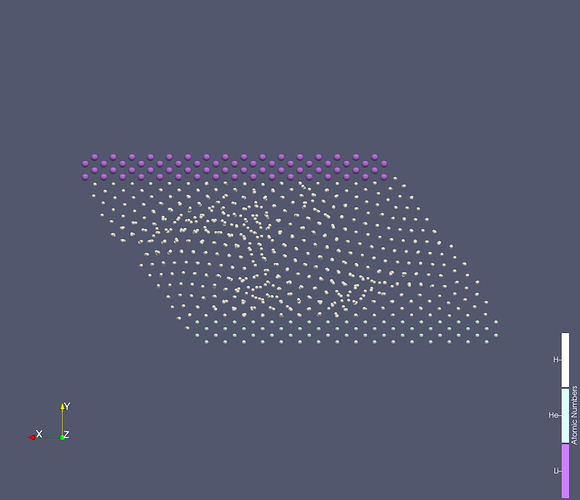Hi, fellow LAMMPSer’s. I am studying the example examples/shear/in.shear. I wonder how to shear the specimen as in this example (see figure below), but in a quasi-static way, such that the kinetic energy of the atoms is 0.
In particular, the example applies a velocity to the upper layer group of the atoms to generate the shear deformation. But in this way the KE of the atoms are not 0. I wonder how to generate a similar shear deformation by “pushing” the upper layers of the atoms in a quasi-static manner? I also listed my attemps. It is greatly appreciated if you could point me to a similar example code (i.e., quasi-static shear) or hint on the correct command.
Here were my attemps.
- First, I tried applying a traction to the upper layers, as in the following code snipet, but it didn’t have any effect. I suspect that I need to specify a potential energy in this case, but can’t find any detailed explanation on how to define this “variable with name that calculates the potential energy”. (Any hint or example on defining the potential is appreciated!)
# Defining the system; same as the example: examples/shear/in.shear but removed all the fix and velocity commands.
variable n equal 10
variable i loop $n
label loop_i
variable shearforce equal $i*1000.0
variable shearforce2 equal $i*(-1000.0)
fix upshear upper addforce ${shearforce} 0.0 0.0
fix lowshear lower addforce ${shearforce2} 0.0 0.0
minimize 0.0 ${tol} 100000 1000000
run 1
next i
- Then I tried directly moving the upper layer atoms, as in the following code. This time, only the upper layer atoms are displaced. The other atoms are not sheared.
variable s equal 0.5
variable i loop $n
# increment (2)
label loop_i
variable strain equal $i*$s
print ">>> step $i, total strain ${strain}"
displace_atoms upper move ${strain} 0 0 units lattice
minimize 0.0 ${tol} 100000 1000000
run 1
next i
- I also tried
change_boxas the following:
# Defining the system; same as the example: examples/shear/in.shear but without all the fix and velocity commands except "fix 2 boundary setforce 0.0 0.0 0.0"
variable dgamma equal 0.5
variable n equal 10
variable i loop $n
label loop_i
change_box all xy delta ${dgamma} remap units lattice
minimize 0.0 ${tol} 100000 1000000
run 1
next i
jump in.shear loop_i
However, in this case, the whole specimen is sheared, so the dislocation happens at multiple places. This case does not match the example, where only the upper layer is being “pushed”.
Thank you in advance.
